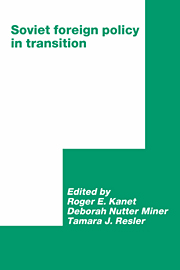Book contents
- Frontmatter
- Contents
- List of tables
- List of contributors
- Preface
- Introduction
- Part I The Soviet Union and the international political system
- Part II The Soviet Union and Europe
- Part III The Soviet Union and the developing world: global trends
- Part IV The Soviet Union and the developing world: regional and country case studies
- Part V Conclusion
- Index
Introduction
Published online by Cambridge University Press: 05 February 2012
- Frontmatter
- Contents
- List of tables
- List of contributors
- Preface
- Introduction
- Part I The Soviet Union and the international political system
- Part II The Soviet Union and Europe
- Part III The Soviet Union and the developing world: global trends
- Part IV The Soviet Union and the developing world: regional and country case studies
- Part V Conclusion
- Index
Summary
The chapters in this book were written over the period of an extraordinary twelve months from March of 1990 to March of 1991, a year which saw the last events of Gorbachev's reforms – the creation of the post of President of the USSR (eventually to be elected by popular vote) and of Presidential and Federation Councils, the end of the Communist Party's legal monopoly of power; and, in foreign policy the acceptance of the reunification of Germany, and the decision by the leadership to support the US-sponsored resolution in the United Nations permitting the use of force in the Persian Gulf by a US-led coalition against a former Soviet ally. The year also witnessed the beginning of what can only be called reaction caused by the unexpected consequences of Gorbachev's ambitious changes. This reaction took the form of an embargo against Lithuania, a long wait for resolution of the debate over economic reform, capped by the defeat in September 1990 of Shatalin's 500-day plan, Gorbachev's assumption of emergency powers in September, outbursts in the Supreme Soviet by conservative officers, the resignation speech by Foreign Minister Shevardnadze warning of impending dictatorship and his actual resignation, the appointment of conservatives to the posts of Minister of the Interior and Vice-President coupled with the abandonment of Gorbachev by important reformers, the placing of units of the armed forces to patrol the streets in the cities, and the death of fifteen people in Vilnius at the hands of the Soviet army in the course of storming the TV tower.
- Type
- Chapter
- Information
- Soviet Foreign Policy in Transition , pp. 1 - 6Publisher: Cambridge University PressPrint publication year: 1992
- 1
- Cited by



